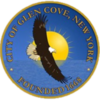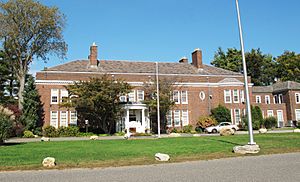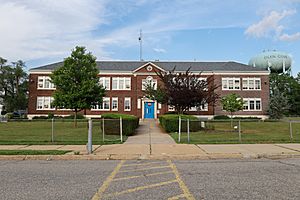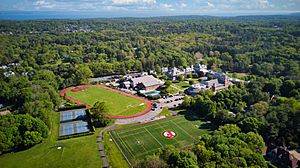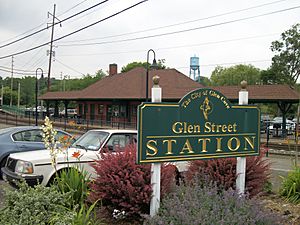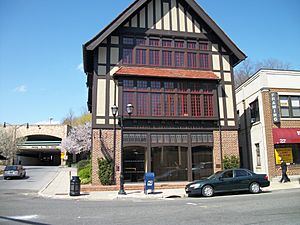Glen Cove, New York facts for kids
Quick facts for kids
Glen Cove, New York
|
||
|---|---|---|
| City of Glen Cove | ||
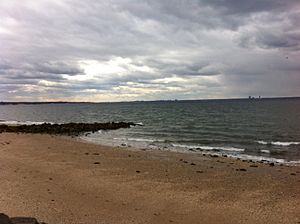
View of Long Island Sound to the north from Welwyn Preserve in Glen Cove
|
||
|
||
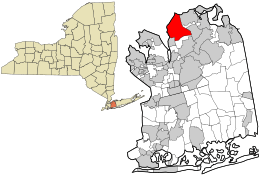
Location in Nassau County and the state of New York
|
||
| Country | ||
| State | ||
| County | Nassau | |
| Incorporated | 1918 | |
| Government | ||
| • Type | Mayor-Council | |
| Area | ||
| • Total | 19.24 sq mi (49.84 km2) | |
| • Land | 6.66 sq mi (17.24 km2) | |
| • Water | 12.59 sq mi (32.60 km2) | |
| Elevation | 23 ft (7 m) | |
| Population
(2020)
|
||
| • Total | 28,365 | |
| • Density | 4,260.29/sq mi (1,644.93/km2) | |
| Time zone | UTC-5 (EST) | |
| • Summer (DST) | UTC-4 (EDT) | |
| ZIP Codes |
11542, 11545, 11560
|
|
| Area codes | 516, 363 | |
| FIPS code | 36-29113 | |
| GNIS feature ID | 0977339 | |
Glen Cove is a city in Nassau County, on the North Shore of Long Island, New York, United States. The city's population was 28,365 at the time of the 2020 census.
Of Nassau County's five municipalities, Glen Cove is one of two that are cities, rather than towns – the other being Long Beach.
Glen Cove was considered part of the affluent, early 20th-century Gold Coast of Long Island, as the properties located along the area's waterfront were initially developed as large country estates by wealthy entrepreneurs and businessmen (such as J.P. Morgan, Phipps, Pratt, and Prybil).
Historically, with the onset of the Industrial Revolution, Glen Cove blossomed in the areas of manufacturing, agriculture and local retail, all of which were operated and staffed by a diverse workforce. The local opportunities—for potential business owners, entrepreneurs, and those seeking employment—attracted numerous immigrants from Europe, largely from Ireland, Italy, and Eastern Europe. Since the 20th century, Glen Cove has also become the home for new waves of immigrants seeking opportunities from Central and South America, as well as parts of Asia.
Contents
History
Ancient cultures of indigenous peoples had lived in the area for thousands of years. At the time of European contact, bands of the Lenape (Delaware) nation inhabited western Long Island and the areas along today's New York Harbor and adjacent New Jersey, as well as further south down the coast, through present-day Pennsylvania and Delaware, and along the Delaware River. They spoke an Algonquian language. By 1600, however, the band inhabiting this local area was called the Matinecock (Metoac), after their location.
Glen Cove was used as a port by the English, and for those coming and going further inland to New England. On May 24, 1668, Joseph Carpenter of Warwick, Rhode Island, purchased about 2,000 acres (8.1 km2) of land to the northwest of the Town of Oyster Bay from the Matinecock. Later that year, he admitted four male residents of Oyster Bay as co-partners in the project—the brothers Nathaniel, Daniel, and Robert Coles along with Nicholas Simkins. The five young men named the settlement 'Musketa Cove Plantation', musketa meaning "place of rushes" in the Lenape language.
19th century
In the 1830s, steamboats started regular service on Long Island Sound, between New York City and Musketa Cove, arriving at a point still called The Landing. As the Lenape word Musketa was incorrectly associated with the English word mosquito, in 1834, residents changed the name officially to Glen Cove; this was said to be taken from a misheard suggestion of Glencoe (referring to Glencoe, Scotland or Glencoe, Nova Scotia).
Glen Cove added to its population as workers arrived for jobs at the Duryea Corn Starch factory, which operated until 1900. The name Duryea was suggested as a name to replace Mosquito Cove; however, it was later rejected.
By 1850, Glen Cove had become a popular summer resort for New York City residents. The Long Island Rail Road was extended to Glen Cove in 1867, providing quicker, more frequent services to New York City. The availability of the train, and the town's location on Long Island Sound, made it attractive to year-round residents, thus the population increased.
The vistas afforded from Long Island Sound of the town's rolling hills attracted late 19th-century wealthy industrial barons, including Charles Pratt and his sons, Charles Anderson Dana as well as J.P. Morgan, and F.W. Woolworth. They built large, private estates along the island's North Shore. This expanse of settled wealth was part of what became known in the 1920s as the Gold Coast of Nassau County. Part of the Morgan property was donated to the city, and it is now operated as Morgan Park and Beach.
20th century
On January 1, 1918, Glen Cove became an independent city, separating from the Town of Oyster Bay, after 250 years. The incorporation was driven by a desire for its tax revenues to be used locally, rather than distributed throughout Oyster Bay. Glen Cove, at the time, was an especially wealthy part of the town, but the town's provisions for Glen Cove's police service and roads were seen as "inadequate", given the amount of taxes levied. It was unusual in that Glen Cove was incorporated as a city without ever having been an incorporated village.
Prior to the mid-20th century, most of the mansions were expanded for uses beyond simply residential. Winfield Hall, the former estate of F.W. Woolworth, is privately-owned.
Altogether, five Pratt families owned a total of about 5,000 acres (20 km2) in the area. John Teele Pratt's estate (The Manor, designed by Charles A. Platt) is operated as the Glen Cove Mansion Hotel and Conference Center.
The Braes, the country estate of Herbert L. Pratt, was purchased by the Webb Institute in 1945. After renovation, it opened the facility in 1947 as an established specialty college for naval architecture and engineering.
George DuPont Pratt's estate, Killenworth, was purchased by the Soviet Union in 1951, for use by its United Nations (UN) delegation. The Russians have used it for decades, both to house visitors and as a weekend retreat for its UN staff. In 1960, while visiting New York for UN meetings, Nikita Khrushchev (former premier of the Soviet Union) and Fidel Castro (then president of Cuba), both stayed at Killenworth.
Like many other suburbs, Glen Cove grew rapidly in population after World War II when new residential developments were completed on former pastureland and farms. Many new residents, at the time, were the second- or third-generation children of Eastern and Southern European immigrants, relocating from their family homes in Queens or Brooklyn. Many African Americans were direct descendants of slaves from the colonial period, as colonists had imported West African slaves for domestic work and farm labor; still others were descendants of migrants from the South who had moved to New York City and the surrounding areas during the Great Migration of the first half of the 20th century.
Since the late 20th century, immigrants to the city have been prominently Latin American and East and South Asian. A Sikh gurdwara established in Glen Cove draws members from the ethnic Indian population in the area.
Geography
According to the United States Census Bureau, the city has 19.2 square miles (50 km2), of which 6.7 square miles (17 km2) is land and 12.6 square miles (33 km2) – or 65.51% – is water.
The city is on the North Shore of Long Island, bordering the Long Island Sound. The hills that stretch along the shore are part of the Harbor Hill Moraine – a terminal moraines left by glaciers of the last ice age.
Glen Cove is bordered on three sides by the Town of Oyster Bay, and on the fourth by the Long Island Sound.
Climate
Glen Cove has a humid subtropical climate (Cfa) that was hot-summer humid continental (Dfa) until the most recent temperature numbers. The monthly average ranges from 32.7 °F in January to 75.5 °F in July. All months now average above freezing, seven months are above 50 °F, and July and August are above 22 °C (71.6 °F.).
Greater Glen Cove area
Glen Cove consists of 1 city, 4 villages and 4 unincorporated hamlets
- Glen Cove
- Glen Head
- Glenwood Landing
- Sea Cliff
- Locust Valley
- Old Brookville
- Matinecock
- Lattingtown
- Greenvale
Note: Locust Valley, Matinecock & Lattingtown are also part of the greater Oyster Bay Area, Old Brookville is also part of the greater Jericho area & Greenvale is also part of the greater Roslyn Area.
Demographics
| Historical population | |||
|---|---|---|---|
| Census | Pop. | %± | |
| 1920 | 8,664 | — | |
| 1930 | 11,430 | 31.9% | |
| 1940 | 12,415 | 8.6% | |
| 1950 | 15,130 | 21.9% | |
| 1960 | 23,817 | 57.4% | |
| 1970 | 25,770 | 8.2% | |
| 1980 | 24,618 | −4.5% | |
| 1990 | 24,149 | −1.9% | |
| 2000 | 26,622 | 10.2% | |
| 2010 | 26,964 | 1.3% | |
| 2020 | 28,365 | 5.2% | |
| U.S. Decennial Census | |||
According to the 2010 U.S. census, Glen Cove had a population of 26,964. In 2000, the city had a population of 26,622 people, 9,461 households, and 6,651 families residing in the city limits; in 2000 its population was spread out at 4,006.0 people per square mile (1,545.7/km2). The 2019 American Community Survey determined Glen Clove's population increased to 27,166.
At the 2000 U.S. census, there were 9,461 households, out of which 29.9% had children under the age of 18 living with them, 53.5% were married couples living together, 12.7% had a female householder with no husband present, and 29.7% were non-families. In 2000, 24.1% of all households were made up of individuals, and 11.3% had someone living alone who was 65 years of age or older. The average household size was 2.72 and the average family size was 3.22. In the city, the population was spread out, with 21.2% under the age of 18, 8.1% from 18 to 24, 30.6% from 25 to 44, 22.6% from 45 to 64, and 17.5% who were 65 years of age or older. The median age was 39 years. For every 100 females, there were 92.8 males. For every 100 females age 18 and over, there were 89.4 males.
The median income for a household in the city was $89,000 and the median income for a family was $108,000 in 2000. Males had a median income of $61,900 versus $40,581 for females. The per capita income for the city was $26,627.
In 2019, there were 9,811 households, out of which 20.3% had children under the age of 18 living with them, and 52.2% of the city population were female. Glen Clove had an owner-occupied housing rate of 52.5% and there was an average of 2.70 persons per household from 2015 to 2019. The city had a median household income of $80,702 and per capita income of $40,703. Of the total population, 13.8% were estimated to live at or below the poverty line.
Race and ethnicity
According to the 2019 American Community Survey, the U.S. Census Bureau determined 54.7% of the population was non-Hispanic white, 8.4% Black or African American, 1.0% American Indian or Alaska Native, 5.3% Asian, 2.7% two or more races, and 25.8% Hispanic or Latin American of any race. In 2010, the racial and ethnic makeup of Glen Cove was 74.2% White (59.4% non-Hispanic white), 7.2% African American, 4.6% Asian, 10.1% some other race, 3.2% two or more races, 0.4% Native American, and 0.1% Hawaiian or Pacific Islander. Hispanics or Latinos of any race made up 27.9% of the population. At the 2000 census, the racial makeup of the city was 60.28% White, 26.40% African American, 0.29% Native American, 4.11% Asian, 0.05% Pacific Islander, 5.72% from other races, and 23.15% from two or more races. Hispanics or Latinos of any race were 20.0% of the population.
Economy
Acclaim Entertainment had its headquarters in One Acclaim Plaza, located in Glen Cove. Acclaim bought the three-story, 65,000 square feet (6,000 m2), Class A office building in 1994 for $4 million.
Glen Cove Creek was channelized in the early 20th century by the US Army Corps of Engineers.
Li Tungsten produced tungsten powder and tungsten carbide powder, along with other specialty products. The company was first known as Wah Chang Smelting and Refining Company, and later as Teledyne Wah Chang.
Columbia Ribbon and Carbon Manufacturing Company opened a Glen Cove research lab in 1932 and produced blue printing inks, carbon paper and typing ribbon until 1980.
Powers Chemco, which made photographic equipment and supplies, was renamed Chemco Technologies in 1987. It was later purchased and renamed Konica Imaging U.S.A., and is today known as Konica Minolta Holding USA Inc. The company closed its Glen Cove factory in 2006 and moved to Michigan.
In 1953 and 1958, Pall Corporation established factories to make filtration products. One site was occupied until 1999, the other until 1971, when the building was sold to August Thomsen Corp.
Photocircuits Corporation began manufacturing circuit boards in 1951, and employed 740 workers when it closed in 2007.
Another company, Slater Electric, began making electrical wiring devices in 1956.
In 1988, Pass and Seymour manufactured electric components using an injection molding process.
Formerly, Gladsky Marine operated a marina and marine repair facility along Glen Cove Creek from the early 1970s until 1999. The site was listed by the EPA as a cleanup site. The remediation of semi-volatile organic compounds and metals from the facility was completed in 2010.
Culture
- The Morgan Park Music Festival holds free concerts on Sunday evenings during July and August at the gazebo in Morgan Park.
- Glen Cove is the headquarters of the American Stamp Dealers Association.
- Welwyn, the former Harold Pratt estate, is a 204-acre (0.83 km2), densely wooded preserve open to the public. It features nature trails and a variety of habitats, including a wooded stream valley, fresh water ponds and swamps, a coastal salt marsh, and a stretch of Long Island Sound shoreline. More than 100 species of birds and a variety of small native mammals, reptiles and amphibians inhabit the preserve's grounds. It is the site of the Holocaust Memorial & Tolerance Center, which offers exhibits and other educational programs.
Sister city
Its sister city is Sturno, Italy, where many immigrants came in the 20th century and settled in Glen Cove.
Education
Public schools
The city of Glen Cove and its residents are served by the Glen Cove City School District. Children who live in the City attend the Eugene J. Gribbin/ Katherine A. Deasy Elementary schools for grades K-2 (pre-k offered at Deasy), Landing/Margaret. A. Connolly schools for grades 3–5, Robert M. Finley Middle School for grades 6–8, and Glen Cove High School for grades 9–12. Finley Middle School was one of ten NASSP Breakthrough Schools. The Glen Cove City School District's "Paired Plan" for elementary schools has the Gribbin and Connolly schools paired, as well as the Deasy and Landing schools. All students from across the city attend joint classes in the central Middle and High schools.
Private schools
There are several private educational institutions inside the city limits:
- All Saints Regional Catholic School, which closed in 2019 [49]
- Friends Academy (pre-K – 12) is a Quaker-founded private school that is located within the City of Glen Cove but has a Locust Valley mailing address.
- Webb Institute of Naval Architecture and Marine Engineering, a four-year college
Transportation
The city of Glen Cove is served by the following mass transit services:
Rail
The Oyster Bay Branch of the Long Island Rail Road has three stations within the boundaries of the city: Sea Cliff, Glen Street, and Glen Cove.
Bus
Local bus service
Nassau Inter-County Express provides service on two routes: N21 (to Great Neck, except Sundays to Roslyn) and N27 (to Hempstead). There is also local service within the city.
Express bus service
North Fork Express offers weekday commuter service between Glen Cove and Manhattan with stops in Midtown and the Wall Street area.
Proposed ferry service
The city has long planned a ferry service direct to Midtown Manhattan. Although initially planned to launch in 2020, the launch of the service has been postponed due to the COVID-19 pandemic and its effect on transportation demand. The city now plans to start service if demand for ferry service returns. The city has put out a survey in 2022 to see if such demand exists.
Landmarks
The United States Post Office at Glen Cove, built in 1932 during the Great Depression, was listed on the National Register of Historic Places in 1989. The Justice Court Building, the former city court and later city hall and police headquarters, was added to the National Register in 1990. It has been renovated and adapted for use as the North Shore Historical Museum. The Old Glen Cove Post Office on Glen Street was listed on the National Register in 2010; it is now used as an architect's office.
Notable people
- Laurie Bird – film actress
- Leslie Buck – businessman, designer of the Anthora coffee cup
- Roy Campanella – baseball player with the Brooklyn Dodgers
- Daniel Daly – United States Marine, double medal of honor recipient
- Howard Davis Jr. – boxer
- Dave Dictor – founding member, vocalist of MDC (Millions of Dead Cops)
- Ashanti Douglas – singer and actress
- John Edward – psychic medium
- Whitey Ford – Yankees baseball player
- Mike Grella – professional soccer player for the Coloumbus Crew SC
- Priscilla Johnson McMillan - journalist and writer
- Carl Karilivacz – NFL player
- Robert F. Kennedy – United States Attorney general, Senator, and presidential candidate
- Nick Markakis – baseball player
- Brian Myers – professional wrestler
- Samuel Pierce - attorney and politician
- Thomas Pynchon – novelist
- Christine C. Quinn – former member of the New York City Council and former Speaker of the NYC Council, politician, housing activist, homeless advocate and organization manager, former head of Anti-Violence Project, CEO and President of Women in Need
- Chuck Schuldiner – founding member, guitarist, and vocalist of the death metal band Death
- Susan Sensemann – artist
- Tom Suozzi – former Nassau County Executive and U.S. Congressman
- MaliVai Washington – tennis player
- Stan Wattles – racing driver
See also
 In Spanish: Glen Cove para niños
In Spanish: Glen Cove para niños


